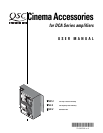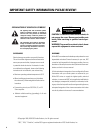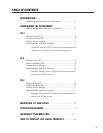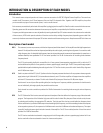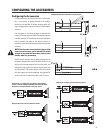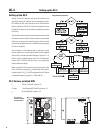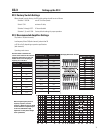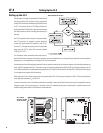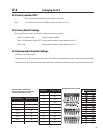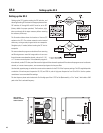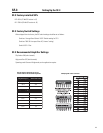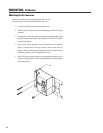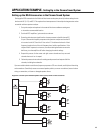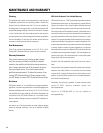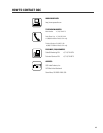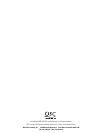
4
INTRODUCTION & DESCRIPTION OF EACH MODEL
XC-3 This accessory is a two-way crossover, with the low frequency band fed to channel 1 of the amplifier and the high frequencies to
channel 2. An all-pass filter on the low frequency band delays the audio signal, permitting time alignment of a cone driver with
a high-frequency horn. A selectable high-frequency boost circuit provides several increments of compensation for screen loss or
constant-directivity horn equalization. A HF trim control provides 0 to 20 dB of attenuation for matching levels between
frequency bands.
The XC-3 can be used by itself with one amplifier for a 2-way system (shown opposite page, bottom-left), or with the LF-3
and an additional amplifier for 3-way systems, as shown, opposite page, bottom-right. The XC-3 has a pass-through output in
parallel with the input for distributing the audio signal to the LF-3. The filter circuitry uses a 4th-order Linkwitz-Riley alignment
with 24 dB/octave slopes.
LF-3 Used in a system with the XC-3, the LF-3 performs the low-frequency crossover functions in a 3-way system as shown, opposite
page, bottom-right. Unlike the XC-3, it has two discrete channels; one LF-3 with an amplifier will support two other amplifiers
with two XC-3 accessories, as shown. The 4th-order Linkwitz-Riley low-pass filters have 24 dB/octave slopes.
Each channel has an all-pass filter providing delay for time alignment. Frequency and delay parameters for both channels
are set individually, although typically they would be set the same.
Each channel has a trim control that provides 0 to 20 dB of attenuation for matching levels among the various frequency
bands.
SF-3 The SF-3 Subwoofer Filter has two summed inputs and a bandpass filter that defines the frequency range of the subwoofer
program. The frequencies of the 2nd-order high-pass and 4th-order Linkwitz-Riley low-pass filters are both set by the user
by selecting and installing the appropriate SIP networks. The high-pass filter also has a switchable low-frequency boost
feature: switched on, it provides a 6 dB bump at the selected high-pass frequency, useful for extending the low-end response
of some speaker systems; off, the response is a flat Butterworth curve that is 3 dB down at the selected frequency. The output
is parallel, feeding the same signal into both channels of the amplifier. The SF-3 has no delay function. A level trim control
provides 0 to 20 dB of attenuation.
The SF-3 can be used to derive subwoofer-range program from full-range audio, as shown, opposite page, bottom-left. It can
also be used with a discrete subwoofer channel in cinema sound systems.
Introduction
Description of each model
This manual covers setup and operation of cinema crossover accessories for QSC DCA Digital Cinema Amplifiers. There are three
models: the XC-3 crossover, the LF-3 low frequency filter, and the SF-3 subwoofer filter. Together with DCA amplifiers, they allow
you to assemble any type of cinema sound system, mono or multi-channel.
Each accessory mounts directly to the back of the amplifier by plugging into the amplifier’s DataPort and is secured with three screws.
Operating power and all connections between the accessory and amplifier are provided by the DataPort connection.
Frequency and delay parameters are user-adjustable by inserting selected 8-pin SIP resistor networks into sockets on the underside
of the accessory. A DIP switch permits selection of functions such as delay and high-frequency boost, depending upon model. Each
accessory includes an assortment of the proper SIP resistor networks and three mounting screws. Keep the unused SIPs for future use.



